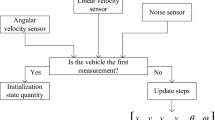Abstract
With the rapid development of economic and scientific levels, urban traffic in China has been further improved. Moreover, the number of private cars is increasing because of the improvement of living standard. However, various traffic problems such as traffic jam, traffic accidents, disordered traffic order and unreasonable travel structure come along. Therefore, the utilization and development of urban intelligent traffic is an inevitable choice for the improvement of Chinese traffic. This study mainly investigated the application of wireless sensor network in urban intelligent traffic information acquisition. Differential Time of Arrival (DTOA) technology, least square method and Kalman filter algorithm were used to improve the location accuracy of vehicles. Moreover, Matlab simulation experiment was performed. The method proposed in this study can improve the acquisition speed of information and positioning accuracy of vehicles. This work is beneficial to the solution of traffic disorder.


Similar content being viewed by others
REFERENCES
Yanxiao, L., Haoshan, S., and Shuiping, Z., An energy-efficient MAC protocol for wireless sensor network, in Future Wireless Networks and Information Systems, Springer Berlin Heidelberg, 2012.
Tirachini, A., Hensher, D.A., and Rose, J.M., Multimodal pricing and optimal design of urban public transport: The interplay between traffic congestion and bus crowding, Transp. Res. Part B: Methodol., 2014, vol. 61, no. 2, pp. 33–54.
Weiyi, Z., Guan, W., Ailing, H., and Junfang, T., SUE model based on a reliability-admissible reasonable route set, Fifth International Joint Conference on Computational Sciences and Optimization. IEEE, 2012, pp. 458–461.
Ying, Y., Catharin, E.F., and Jeffrey, F.C., Detecting depression severity from vocal prosody, IEEE Trans. Affective Comput., 2013, vol. 4, no. 2, pp. 142–150.
Zhai, Y. and Yeary, M., A new particle filter tracking algorithm for DOA sensor systems, IEEE Instrumentation & Measurement Technology Conference IMTC. IEEE, 2007, pp. 1–4.
Tailin, C., Parameswaran, R., and Kewal, K.S., WSN19-3: Optimal sensor distribution for maximum exposure in a region with obstacles, Global Telecommunications Conference, 2006. GLOBECOM '06, San Francisco, CA, USA, November 27 –December 1: DBLP, 2006, pp. 1–5.
Bejar, R., Krishnamachari, B., Gomes, C., and Selman, B., Distributed constraint satisfaction in a wireless sensor tracking system, Workshop on Distributed Constraint Reasoning, IJCAI-01, 2001.
Tenqchen, S., Yinghaw, S., Mingchang, S., and Wushiung, F., Blind signal extraction algorithm for the license plate matching of vehicle positioning system, IEEE International Conference on Field-Programmable Technology, 2004, pp. 440–442.
Ziyi, Y., An unequal clustering strategy for WSNs based urban intelligent transportation system, J. Inf. Comput. Sci., 2015, vol. 12, no. 10, pp. 4001–4012.
Jirui, L. and Kai, Y., Improvement of path planning in mobile beacon assisted positioning, Advanced Intelligent Computing Theories and Applications with Aspects of Artificial Intelligence, International Conference, ICIC, Zhengzhou, China, August 11–14, 2011, Revised Selected Papers. DBLP, 2011, pp. 309–316.
Zijuan, C. and Qingzhong, K., A vehicle management system of community based on radio frequency identification technology, IEEE International Conference on Communication Software and Networks, 2011, pp. 341–343.
Dongqing, W., Feng, D., and Yanyun, C., Data filtering based recursive least squares algorithm for Hammerstein systems using the key-term separation principle, Inf. Sci., 2013, vol. 222, no. 3, pp. 203–212.
Feng, S. and Lijun, T., Cubature Kalman filter—Kalman filter algorithm, Control Decis., 2012, vol. 27, no. 10, pp. 1561–1565.
Nan, H. and Shengchuan, Z., Discussion of basic elasticity models applied to induced traffic in China, J. East. Asia Soc. Transp. Stud., 2013, vol. 10, pp. 1687–1700.
Jianping, Z., Baotong, W., and Haiqing, X., Improved Kalman filter algorithm in positioning system for autonomous mobile robot, Appl. Res. Comput., 2011, no. 5, pp. 1710–1712.
Bokui, C., Yanbo, X., Wei, T., Chuanfei, D., Dongmei, S., and Binghong, W., A comprehensive study of advanced information feedbacks in real-time intelligent traffic systems, Phys. A Stat. Mech. Its Appl., 2012, vol. 391, no. 8, pp. 2730–2739.
Author information
Authors and Affiliations
Corresponding author
Additional information
The article is published in the original.
About this article
Cite this article
Niqin Jing Application of Wireless Sensor Network in Urban Intelligent Traffic Information Acquisition. Aut. Control Comp. Sci. 52, 431–438 (2018). https://doi.org/10.3103/S0146411618050103
Received:
Accepted:
Published:
Issue Date:
DOI: https://doi.org/10.3103/S0146411618050103




